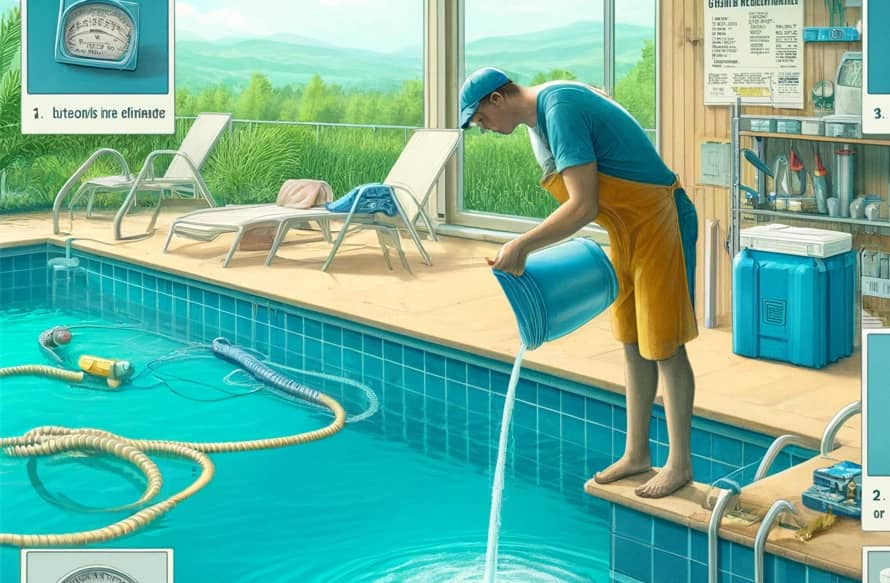Maintaining a crystal-clear pool requires regular cleaning and balancing of chemicals, but sometimes regular maintenance isn’t enough, especially after a heavy pool day, a storm, or when the water starts to look cloudy. That’s where shocking your pool with calcium hypochlorite comes in. Known for its powerful sanitizing properties, calcium hypochlorite is an effective pool shock treatment that eliminates contaminants, bacteria, and algae, restoring your pool’s pristine condition. This article will walk you through the steps of using calcium hypochlorite for pool shock, including safety tips and key considerations.

Why Use Calcium Hypochlorite to Shock Your Pool?
Calcium hypochlorite, often called “cal hypo,” is a popular choice for pool shock because of its high chlorine content, typically around 65-75%. Unlike liquid chlorine, which degrades faster in storage, calcium hypochlorite has a longer shelf life and delivers a quick, powerful oxidation boost to your pool water. It’s particularly effective at killing bacteria, removing algae, and neutralizing organic contaminants. Whether you’re using it for weekly maintenance or after heavy pool use, calcium hypochlorite provides reliable, thorough sanitization.
Choosing the Right Calcium Hypochlorite Product
Before starting the shock process, it’s important to select the right form and amount of calcium hypochlorite. Products like calcium hypochlorite tablet are convenient for routine chlorination, while granulated forms are generally preferred for shock treatments due to their rapid dissolution. For large or commercial pools, bulk options such as 100 lb calcium hypochlorite containers are also available, which can be more economical.
How Much Calcium Hypochlorite Should You Use?
To shock your pool effectively, you need to know the proper amount of calcium hypochlorite to use. The general rule is to add 1 pound of calcium hypochlorite for every 10,000 gallons of water to raise chlorine levels by about 10 parts per million (ppm). However, you may need to adjust this based on your pool’s needs:
1.Routine Maintenance Shock:
Raise chlorine to around 10 ppm. Use 1 pound per 10,000 gallons.
2.Algae or Bacteria Outbreak:
Raise chlorine to 20-30 ppm. This may require 2-3 pounds per 10,000 gallons, depending on the severity.
3.Heavy Use or Post-Storm Shock:
Raise chlorine to around 15-20 ppm. Use 1.5-2 pounds per 10,000 gallons.
For large pools or frequent shock needs, investing in 100 lb calcium hypochlorite packages can be more practical and cost-effective, allowing you to maintain an ample supply on hand.
Step-by-Step Guide to Shocking Your Pool with Calcium Hypochlorite
1. Test Your Pool Water:
Before adding any chemicals, test your pool water for current chlorine and pH levels. Ideally, your pool pH should be between 7.2 and 7.4 for the shock to be most effective. Adjust if necessary.
2. Prepare Your Calcium Hypochlorite Solution:
Calcium hypochlorite can be added directly to the pool, but pre-dissolving it in a bucket of water is recommended to avoid bleaching pool surfaces and ensure even distribution. Add the measured amount of calcium hypochlorite to a large bucket of warm water and stir until dissolved. Use caution, as cal hypo is a strong oxidizer.
3. Add to Pool Water:
Pour the solution around the edges of the pool, focusing on areas with less circulation. Be sure to avoid adding the solution near metal fittings or fixtures, as high chlorine levels can cause corrosion over time. For added convenience, some products, such as calcium hypochlorite shock, come pre-packaged and ready to apply directly, simplifying the process.
4. Let the Shock Circulate:
Run your pool pump for at least 8 hours to ensure the calcium hypochlorite shock disperses evenly throughout the water. This circulation period also helps prevent concentrated chlorine spots that can damage your pool liner or surface.
5. Re-Test and Adjust:
After 24 hours, test your pool water again to ensure chlorine levels have returned to a safe range, ideally between 1-3 ppm. If chlorine levels remain high, avoid swimming until they drop to acceptable levels.
Important Safety Tips When Using Calcium Hypochlorite
Calcium hypochlorite is a strong chemical, so handling it safely is essential:
1.Wear Protective Gear:
Always wear gloves and eye protection when handling calcium hypochlorite to prevent irritation or burns.
2.Store Properly:
Keep your calcium hypochlorite in a cool, dry place, away from direct sunlight and moisture. Avoid storing it near other chemicals, especially acids, as it can react violently.
3.Never Mix with Other Chemicals:
Mixing calcium hypochlorite with other pool chemicals can cause dangerous reactions. Handle each chemical separately and rinse tools thoroughly between uses.
Benefits of Using Calcium Hypochlorite for Pool Shock
There are several reasons why many pool owners prefer calcium hypochlorite for shock treatments:
1. Powerful Sanitizing Ability:
With high chlorine content, calcium hypochlorite is highly effective against bacteria, algae, and other organic contaminants.
2. Long Shelf Life:
Calcium hypochlorite, especially in larger packages like 100 lb calcium hypochlorite containers, retains its potency longer than liquid chlorine.
3. Cost-Effectiveness:
For pool owners with large pools or frequent shock needs, calcium hypochlorite is generally more affordable over time.
Conclusion
Using calcium hypochlorite to shock your pool is an effective way to maintain water clarity, sanitation, and safety. By following these steps, you’ll be able to keep your pool in top condition, ensuring safe and enjoyable swimming for everyone. Remember, whether you’re using calcium hypochlorite tablet for regular chlorination or calcium hypochlorite shock for a deep cleanse, safe handling, and proper dosing are key to a sparkling, healthy pool.
